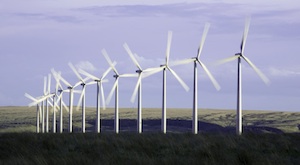This month in the Pacific Northwest, when runoff from a heavy snowpack coincided with extremely windy conditions, the federal Bonneville Power Administration system suddenly had an abundance of alternative energy feeding its system. BPA chose to limit wind-driven power in favor of hydroelectrity during peak water and wind events. The operational policy is likely to chill construction of new wind farms in the Pacific Northwest, according to the American Wind Energy Association.

“This is a damaging precedent,” said Rob Gramlich, senior vice president for public policy for AWEA during a May 23 press conference. “There is a better way.”
BPA on May 13 instituted a policy favoring hydroelectricity over other power sources, including wind, when high flow rates are powering its powerhouse dams. The agency used that policy four times in May, shutting off more than 18,000 MWh of generation in order to avoid spilling water over its dams, and running afoul of federal and state regulations on dissolved gases in the river. The curtailments are likely to continue through the spring as the Northwest is experiencing its highest Columbia basin runoff since 1999.
In one event in May, BPA shut down 1,400 MW of electricity, including about 300 MW of wind power. When the wind power is curtailed, the developers of the wind farms don’t earn money from renewable energy credits based on the electricity generated from wind. They also lose federal production tax credits, also tied to generating wind power. Additionally, the hydropower from BPA’s dams do not count as renewable energy, leaving utilities without renewable energy to meet their state’s renewable mandates.
“This was an extremely difficult decision for me. Despite months of searching through a robust public process, there was no good choice here,” said Steve Wright, BPA administrator in a statement announcing the action. “I believe we have adopted the option that best preserves reliability, protects salmon and avoids increased costs on average to Northwest ratepayers.”
Pat Ford, executive director of Save Our Wild Salmon, said during the May 23 press conference that BPA is presenting a false choice, because water spilled over the dams, rather than run through the turbines, is good for salmon because it helps to carry juvenile salmon to the sea. Gramlich said May 23 that legal action and regulatory action in front of the Federal Energy Regulatory Commission is likely to occur soon. “There’s a preference for keeping other power online,” he said. “BPA has a conflict of interest. It’s like an air traffic controller that owns planes and only allows them to land.” Spring oversupply in the Northwest is not a new problem, but it is worsening with the addition of wind power in the region. The wind often blows the strongest during the spring runoff period. About 3,500 MW of wind power is on the BPA system, with an additional 3,000 MW plus scheduled to come online in the near future.
Gramlich and others during the press conference argued that the issue isn’t necessarily oversupply, but a lack of effort in trying to sell the excess power. Gramlich said that the transmission interties, that take electricity to other markets, were not fully used during the curtailment events earlier in the month. During the oversupply event last year, the intertie was not fully used because of line problems, pricing differences between California and the Northwest and because the intertie was already committed to other parties.
Gramlich and others during the press conference admitted that the problem was not likely to be resolved this season.
A study completed recently by the regional power agency, the Northwest Power and Conservation Council suggests that long-term, oversupply impacts could be lessened by diversifying renewable resources, adding on–stream storage and increasing intertie capacity with California.
The paper suggests that utilities add higher capacity renewable sources, such as biomass, geothermal, hydropower and offshore wind power. The report also points out that more than 70% of the current wind generation is influenced by Columbia Gorge winds, meaning that all of those wind turbines peak at the same time. “Good quality wind resources are found elsewhere in the Northwest and in adjacent regions; however it would be necessary to strengthen or extend the transmission grid,” according to the report.

Post a comment to this article
Report Abusive Comment